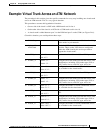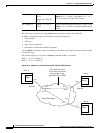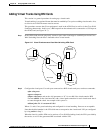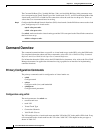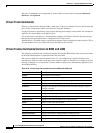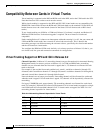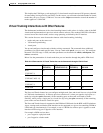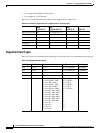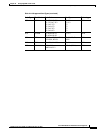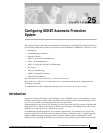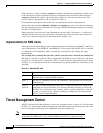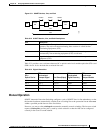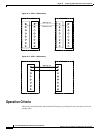
24-25
Cisco BPX 8600 Series Installation and Configuration
Release 9.3.10, Part Number 78-11603-01 Rev. D0, July 2001
Chapter 24 Configuring BXM Virtual Trunks
Compatibility Between Cards in Virtual Trunks
This implies that UXM legacy cards upping all 15 virtual trunks would consume 4320 gateway channels
for networking, leaving none for user traffic. For this reason, you will need to limit the number of virtual
trunksthatyouuponalegacyUXMcard.Youcanusethecnfport command to control the number of
trunks upped on a UXM card.
Virtual Trunking Interactions with Other Features
The fundamental architecture of the virtual trunking feature in this release is similar to that of the BNI
virtual trunk implementation in previous switch software releases. The standard UNI/NNI cell headers
are used across the virtual trunks, and two-stage queueing as defined by the VI interface.
This section discusses some features that interact with virtual trunking, including:
• trunks and ports on the same card
• VSI resource partitioning
• virtual ports
You up and configure virtual trunks with the existing commands. The commands have additional
parameters for virtual trunk specific items. You up a trunk with uptrk
<slot.port.vtrk>. You configure
the trunk VPI (VPI range 1–4095) and other parameters on the trunk with cnftrk, cnftrkparm, and
cnfrsrc commands.
Below lists the permutation of virtual trunks that you can interface through the public ATM cloud.
The Ports and Trunks feature lets you configure multiple trunk lines and circuit lines on a single BXM
or UXM card simultaneously. In releases previous to Release 9.2, when you upped a single port as a
trunk (by using the uptrk command), all the remaining ports on that card are treated as trunks.
Similarly, when you up a single port as a circuit line (by using the upln command), all the remaining
ports on the card are treated as circuit-line ports.
The Ports and Trunks feature is supported on the BXM and UXM cards for the BPX and IGX platforms.
A port, routing trunk and feeder trunk interface can be supported on a given slot containing a BXM or
UXM card type simultaneously. For example, a user of a BXM slot can have port 1 upped as a trunk
interface while having port 2 upped as a line interface.
For example a BXM card can have:
• port 1 upped as a physical trunk
• port 2 upped as a feeder trunk
Table 24-13 Permutation of Virtual Trunks that can be Connected through a Public Cloud
BNIs
(T3/E3/OC-3)
BXM
(T3/E3/OC-3/OC-12)
UXMs
(T3/E3/OC-3) UXM-AIM
BNIs
(T3/E3/OC-3)
yes no no no
BXMs
(T3/E3/OC-3/OC-12)
no yes yes yes
UXMs
(T3/E3/OC-3)
no yes yes yes
UXM-AIM no yes yes yes



